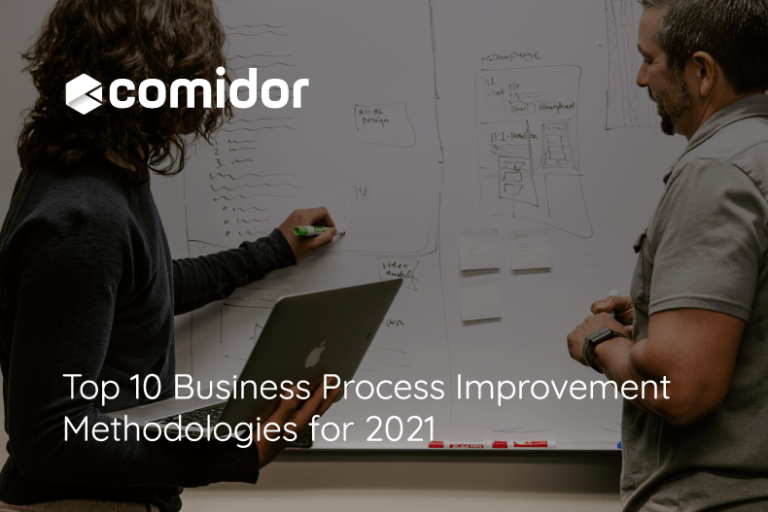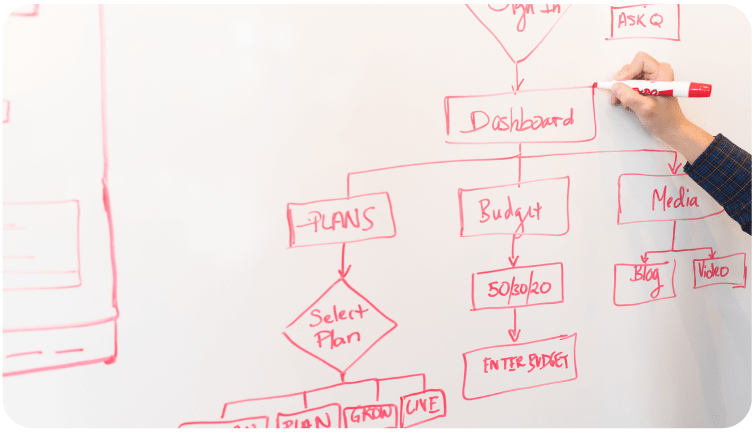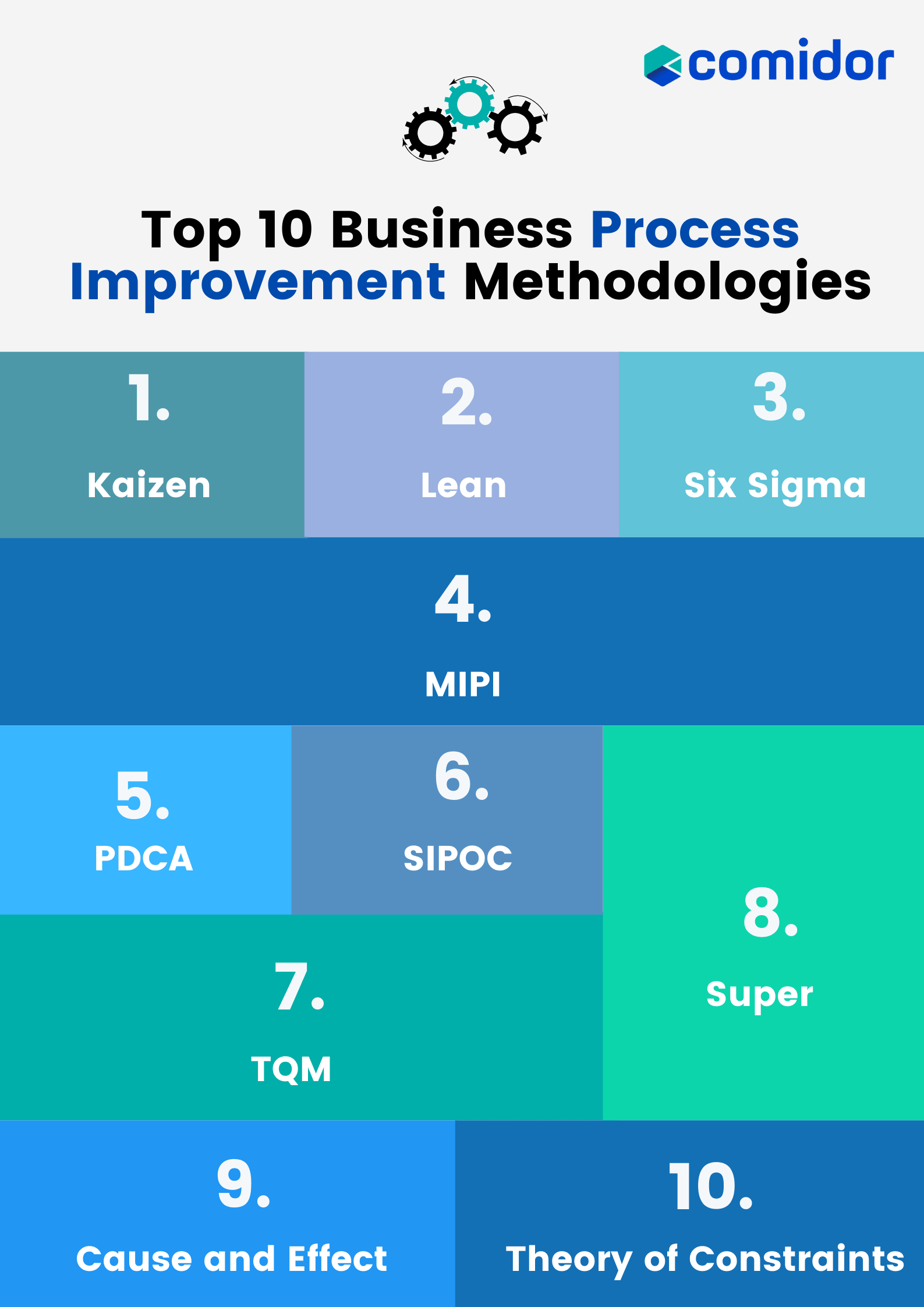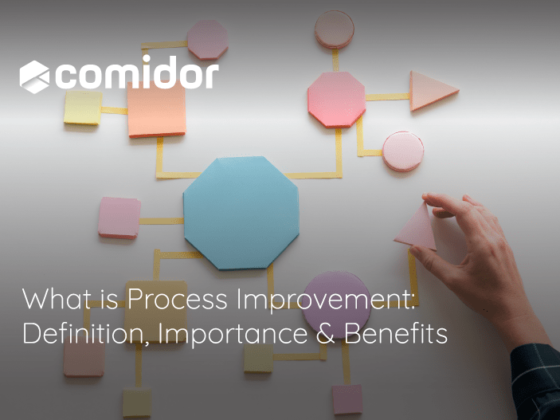No matter the scale at which your business operates, Business Process Improvement (BPI) should be on your radar in 2021. It allows enterprises such as yours to eliminate downtime and improve existing business processes without losing any existing process efficiency or accuracy.
According to published statistics, 31% of businesses have fully automated at least one core process, with 30% also implementing AI for business improvement purposes. Using a Business Process Management (BPM) platform will help you streamline and automate end-to-end business processes. Beyond that, here are the top BPM methods for 2021, which you can implement in tandem with a dedicated BPM platform.
Top 10 Business Process Improvement Methods
1. Kaizen
Kaizen is a BPI methodology that aims for constant growth and improvement within your work processes. While Kaizen is generally used in managerial departments such as QA and waste management, it can be retrofitted for other business process improvement purposes. What makes Kaizen an appealing business process improvement methodology is the fact that it relies on continuous development, problem-solving, and innovation rather than amending issues as they come.
2. Lean
Lean management is no new kid on the block, and that’s what makes it interesting. Lean can help identify bottlenecks in your business pipeline and eliminate any waste in time and resources. This BPI methodology aims to involve as many departments and employees in the process of business improvement spending as few resources as possible. In the age of sustainable business management, lean management has a lot to offer and should be on your BPI radar.
3. Six Sigma
Six Sigma is a BPI methodology that aims to help you manage your business smarter and more efficiently. Its main postulates involve increasing client satisfaction while reducing production time and defects in your workflows. Experts from EssaySupply highlight that Six Sigma can be implemented either through DMAIC (an acronym for Define, Measure, Analyze, Improve and Control) or DMADV (an acronym for Define, Measure, Analyze, Design, Verify) methods depending on your business structure.
4. Model-Based Integrated Process Improvement Methodology
The so-called MIPI methodology is designed with business process efficiency improvement in mind and involves several cascading phases, which have to be executed in sequence. These include:
- Familiarity with your business needs
- Familiarity with existing processes
- Analysis and modeling of processes
- Mapping and redesign of processes
- Implantation of new processes
- Assessment of new processes
- Review of new processes
What makes MIPI methodology attractive is its simplicity and the fact that any business can adopt it easily, thanks to the process phase breakdown. This makes it suitable for both small-scale startups and large-scale enterprises.
5. Plan-Do-Check-Act
As the brainchild of Walter Shewhart, PDCA methodology has proven to be very useful for businesses aiming to improve their productivity. As its name might suggest, PDCA is a BPI methodology separated into four stages:
- Plan: identification of areas with change and improvement potential
- Do: application of proposed changes through pilot implementation
- Check: analysis and review of implemented changes to business processes
- Act: adaptation and fixing of errors as well as full-scale change implementation
The appeal of PDCA is in its reliance on strict and calculated planning as well as the continuous measurement of implementation results. This is a good BPI methodology for business leaders who are wary of making large changes to their business’ workflows without carefully reviewing pilot implementation results.
6. Suppliers, Inputs, Process, Outputs, and Customers
SIPOC is a business process improvement methodology that allows businesses to gather all available data on inputs and outputs of their workflows and analyze it. Some companies prefer to use COPIS, which focuses on the customer and highlights the value of the customer to the organization. SIPOC is useful for identifying any elements necessary for BPI since it involves a comprehensive audit of existing processes.
7. Total Quality Management
Businesses that rely on the agile framework might want to consider using TQM as their preferred business process improvement methodology. It relies on teamwork and agency and represents a framework of tools and standards which will help you meet industry demands. Companies rely on TQM without even realizing it, as it involves being ready and able to meet shifting trends and tides on the open market.
8. Super
Designed with general business process improvement in mind, the Super methodology is split into five parts. Combining two or more phases of this BPI methodology is recommended as your business’ scale goes up. The phases available in Super BPI include:
- Process selection: identification of bottlenecks
- Process understanding: analysis of systems and their components
- Process measurement: a review of current processes and collected data
- Execution: implementation of new processes based on assessments
- Review: analysis of post-implementation data and comparison with pre-BPI data
9. Cause and Effect
This business process improvement methodology enables businesses to identify bottlenecks and their effects on their workflows to find a viable long-term solution. This is an excellent BPI methodology for businesses who know exactly what problems they have in their processes as it will enable them to analyze them. Given that business process issues never happen in a vacuum, Cause and Effect is a useful BPI to keep in mind.
10. Theory of Constraints
Another BPI methodology that involves a five-step process for the identification and elimination of workflow issues is the Theory of Constraints (TOC). Penned by Dr. Eliyahu Goldratt, it involves several steps which aim to structurally eliminate an issue while informing you of its alternatives.
- Identification of a workflow constraint
- Identification of constraint’s exploit
- Constraint synchronization and subordination
- Constraint alleviation
- Repetition until the constraint is eliminated
Settling for the right business process improvement methodology in 2021
Regardless of how well your business processes function at the moment, there is always room for process improvement both from a problem-solving and automation point of view. Review the BPIs we’ve outlined above and try to fit them into your workflow without disrupting existing processes. Having the right BPM software in your business is also beneficial as you won’t have to go about implementing business process improvement methodologies manually.
Author Bio
Jessica Fender is a copywriter and blogger at ThesisOnTime with a background in marketing and sales. She enjoys sharing her experience with like-minded professionals who aim to provide customers with high-quality services.
Streamline, automate and optimize
end-to-end business processes with Comidor








